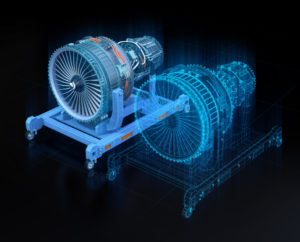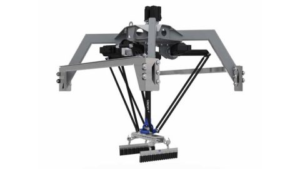
The Multiple Faces of Digital Twins

(sutadimages/Shutterstock)
Digital twins are emerging as a hot technology, particularly among manufacturers and companies involved with the Industrial Internet of Things. Depending on the use cases, though, customers may opt for one type of digital twin over another.
To a certain extent, every digital twin is a unique creation. The ability to create a digitized copy of an actual physical asset, such as a wind turbine or a locomotive, and measure how that model responds and reacts to different inputs is the fundamental breakthrough that is driving adoption of digital twin technologies.
But there are a few broad categories of digital twins, and companies that are considering adopting a digital twin would do well to explore how their use cases match up to these types.
According to Philipp Wallner, the industry manager for MathWorks, there are two general types of digital twins: physics-based twins and data-based twins.
The physics-based digital twin is a detailed reproduction of a well-understood piece of machinery that behaves in a predictable manner, such as a robot or a piece of equipment on a manufacturing line. In some cases, these physics-based digital twins are created by importing CAD files into a simulation platform.
Data-based twins, on the other hand, are models that machineries or processes that are not as well understood and have very complex interactions, such as a compressor. While the physics driving these machines are generally understood, the high number of variables involved, including the shapes of vessels, precludes basing the model directly on physics. However, users do have a large amount of data describing the machine’s behavior, which becomes the basis for the model.
MathWorks helps its customers build both types of digital twins. One of its customers, Krones, developed a digital twin in MathWorks’ software based on CAD drawings of its bottle-handling robot.
“What we offer is a CAD import functionality,” Wallner says. “So you take these CAD models, and you import them. And then you already have a pretty good basis for your model. You still have to add additional parameters and some of the functionality that is not captured in the CAD model.”
Krones initially developed the digital twin in MathWorks’ Simulink software with the idea of monitoring the health of the Robobox T-GM robot, which its customers deploy in the field. By running the digital twin right next to the field-deployed robot, and feeding the twin the same sensor data emanating from the actual robot, its customers could get an early warning of possible problems, such as a bearing that is close to giving out.
“That was the original idea,” Wallner tells Datanami. “But they went one step further and said, well, why not use this to optimize the behavior of the physical asset?”
Customers use the digital twins can vary. For example, in the Krones case, the deployment started out as a healthy monitoring digital twin, but it ended up changing into an optimization digital twin. Companies typically do not run separate digital twins for the same asset. Instead, the same digital twin is used in different ways, Wallner says.
“Once you have a digital twin, you can use that digital twin as a basis to train your machine learning models, for instance, for health monitoring or optimization,” he says.
The head of Analytics and Simulations at Krones, Thomas Albrecht, credits the MathWorks software with improving product development. “The digital twin we created in Simulink and Simscape Multibody enabled us to optimize our hardware design and shorten development and testing times,” says Thomas Albrecht, head of Analytics and Simulations at Krones.
MathWorks’ Simulink software combines machine learning and simulation techniques to allow customers like Krones to try out a number of different scenarios to determine the optimal way to run machinery. All that is required of the human machine owners is to provide a ballpark of reasonable parameters, and the software takes over from there and solves optimization problem automatically, Wallner says.
Digital twins will often be a blend of the different types of digital twins. In Krones case, the company started off with a CAD drawing, which formed the basis of its physics-based digital twin in Simulink. But then the company added additional variables based on data gathered from observing the robot function.
“That’s one of the beauties that Simulink offers here. It’s not like you take either/or,” Wallner says. “You can combine, in one Simulink model, the physics-based graphic, or let’s say the mechanical piece, and then add some [components] that are actually representing a data-driven piece of the model.”
Companies with complex manufacturing processes are more likely to use the data-driven approach, Wallner says.
“If you think about plastics extruder or a company that produces paper or plastic–it’s really difficult to get all the differential equation correct here, but they have tons of measured data,” he says. “You have hundreds of different parameters, or thousands in many cases, that impact the temperature and pressure in that process. And so in these cases, what we see is most of the time it’s easier to just take that, take the measurements that you have and model that.”
MathWorks doesn’t offer a single digital twin product. Instead, its digital twin offering is based on a combination of different software products. Physics-based models will often start with the Simulink family of products, while data-based models will often start with MatLab, its popular line of statistical, AI, and machine learning tools.
What sets MathWorks apart in the growing digital twin world, Walner says, is its deployment scenarios. If the digital twin is going to be deployed onto a programmable logic controller (PLC) or an industrial PC, then Simulink may be used to generate optimized C code that gets embedded on that PC or PLC. If the digital twin is going to live on a server or in a cloud environment, then it would use code generated by either MATLAB or Simulink, he says.
The future for digital twins is bright. According to a 2019 Gartner survey, three-quarters of companies that are implementing IoT already had digital twins in place or planned to within a year. The pandemic accelerated the adoption of digital twins.
“I think it’s definitely taking off,” Wallner says. “It’s mainly where an equipment stoppage or even non-optimal behavior of the equipment would be a big loss in terms of the company’s business–that’s where we see they are most interested in building digital twins and using machine learning techniques.”
Related Items:
Can Digital Twins Help Modernize Electric Grids?
Digital Twins and AI Keep Industry Flexible During COVID-19

































